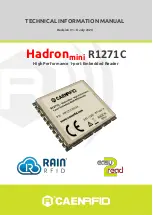
1643725H (404416)
2020-09-28
2
1643725H (404416)
2020-09-28
3
DATE PURCHASED __________________________________________________________________
HOIST SERIAL NUMBER ____________________________________________________________
CYLINDER SERIAL NUMBER
______________________________________________________
DEALER __________________________________________________________________
ADDRESS
__________________________________________________________________
PHONE __________________________________________________________________
FOREWORD
Crysteel’s LB520 Hoist has been designed and intended for use on single-axle trucks with cab-to-axle
dimensions of 72 to 132 inches and body lengths of 9 to 16 feet.
This manual contains information necessary for the proper installation and operation of Crysteel’s Model
LB520 Hoist. Study it carefully before attempting to mount or use the hoist. With proper installation and
maintenance, the Crysteel Model LB520 Hoist will give many years of trouble-free service.
When ordering parts, be sure to give serial number of hoist and cylinder. The serial number of the hoist
is stamped into the hoist frame near the base end of the cylinder. The serial number of the cylinder is
stamped on the barrel of the cylinder near the base. For future reference, copy these numbers NOW in the
space provided above. Order parts by number and description as given in the parts listing in this manual.
1. Engage PTO from cab and adjust engine speed to fast idle.
OPERATION AND USE
SOME DO’S AND DON’TS FOR SAFE AND LONG SERVICE
1. Use the proper hydraulic fluid. KEEP IT CLEAN. Remember to change it regularly.
2. ALWAYS operate the hoist from inside the cab of the truck.
3. If the hydraulic hose connections are correct, the hoist should raise when the hoist control
lever is pulled back, hold when the lever is in the center detent, and lower when the lever
is pushed forward.
4. To raise the hoist, pull the control lever back. To hold the body in a raised position, place
the control lever in its center detent position. To lower the hoist, push the control lever
forward.
5. ALWAYS return the hoist control lever to its center detent position after each use.
6. When the hoist cylinder reaches the end of the stroke, oil will flow through the automatic
bypass valve built into the piston inside the cylinder and return to the reservoir.
7. It is advisable to run the PTO to “power down” or lower the hoist because this will act as
an hydraulic lock to hold the hoist in the lowered position. It is not necessary to do this,
however, because the reservoir has sufficient capacity whether or not the hoist is powered
down. You will benefit from the advantages of the double acting hoist only if you power
down.
8. To make use of the hydraulic lock feature, place the hoist control lever in the center hold
position after the hoist is powered down. This places the pressure on the valve, where it
belongs, not on the pump.
9. DO NOT LEAVE THE PTO IN GEAR WHILE TRANSPORTING. THIS CAN CAUSE
SEVERE DAMAGE TO THE PTO OR HYDRAULIC PUMP.
10. The hydraulic system should be drained, flushed and refilled with proper hydraulic fluid
at regular intervals. CAUTION: NEVER use hydraulic BRAKE FLUID in the hydraulic
system.
11. After adding or replacing the hydraulic fluid, cycle the hoist several times to remove air
from the cylinders and hydraulic hoses.
2. Lubricate all grease fittings every 100 cycles or every two months. Infrequent or insuffi
-
cient lubrication will cause hoist failure and possibly injury or death.
3. ALWAYS carefully block up the body, using the body prop, before working under it.
4. Do not “race” the engine when unloading.
5. Do not load the hoist beyond its capacity.
6. DO NOT tamper with the hydraulic relief valve. This will void the warranty. It can cause
severe damage to the hoist and cylinder.
7. Never leave the PTO in gear while transporting. It could ruin the hydraulic pump, the PTO
or the transmission.
8. Check all bolts and fittings regularly. Keep them tight. See table on page 4 for torque val
-
ues.
9. Always operate hoist on a firm and level surface.
10. Always make sure area around truck is clear and safe for hoist operation and dumping.































